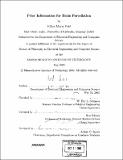Prior information for brain parcellation
Author(s)
Pohl, Kilian Maria
DownloadFull printable version (45.78Mb)
Other Contributors
Massachusetts Institute of Technology. Dept. of Electrical Engineering and Computer Science.
Advisor
W. Eric L. Grimson and Ron Kikinis.
Terms of use
Metadata
Show full item recordAbstract
To better understand brain disease, many neuroscientists study anatomical differences between normal and diseased subjects. Frequently, they analyze medical images to locate brain structures influenced by disease. Many of these structures have weakly visible boundaries so that standard image analysis algorithms perform poorly. Instead, neuroscientists rely on manual procedures, which are time consuming and increase risks related to inter- and intra-observer reliability [53]. In order to automate this task, we develop an algorithm that robustly segments brain structures. We model the segmentation problem in a Bayesian framework, which is applicable to a variety of problems. This framework employs anatomical prior information in order to simplify the detection process. In this thesis, we experiment with different types of prior information such as spatial priors, shape models, and trees describing hierarchical anatomical relationships. We pose a maximum a posteriori probability estimation problem to find the optimal solution within our framework. From the estimation problem we derive an instance of the Expectation Maximization algorithm, which uses an initial imperfect estimate to converge to a good approximation. (cont.) The resulting implementation is tested on a variety of studies, ranging from the segmentation of the brain into the three major brain tissue classes, to the parcellation of anatomical structures with weakly visible boundaries such as the thalamus or superior temporal gyrus. In general, our new method performs significantly better than other :standard automatic segmentation techniques. The improvement is due primarily to the seamless integration of medical image artifact correction, alignment of the prior information to the subject, detection of the shape of anatomical structures, and representation of the anatomical relationships in a hierarchical tree.
Description
Thesis (Ph. D.)--Massachusetts Institute of Technology, Dept. of Electrical Engineering and Computer Science, 2005. Includes bibliographical references (p. 171-184).
Date issued
2005Department
Massachusetts Institute of Technology. Department of Electrical Engineering and Computer SciencePublisher
Massachusetts Institute of Technology
Keywords
Electrical Engineering and Computer Science.